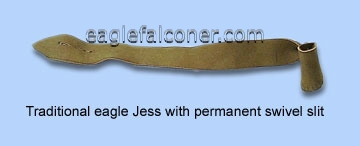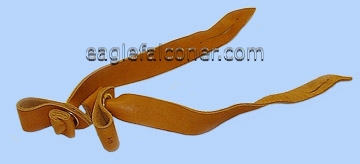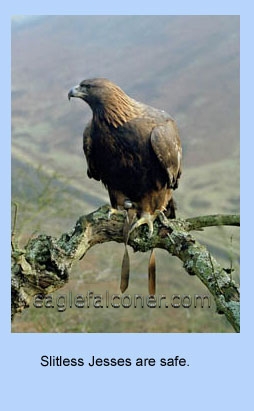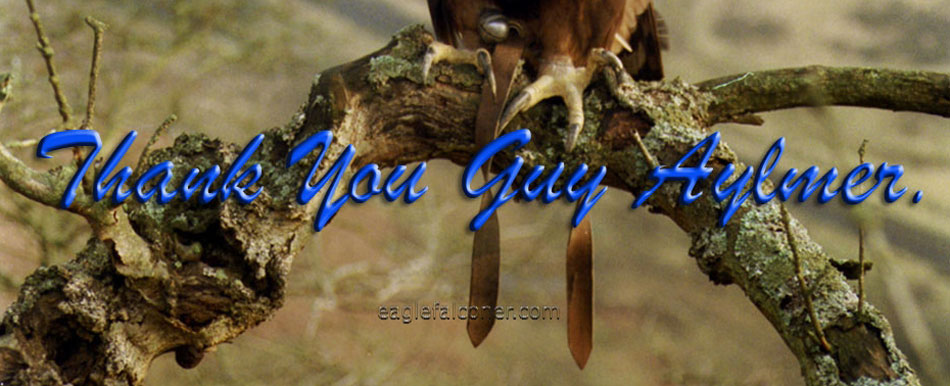‘THANK YOU GUY AYLMER’
by
ALAN GATES
First Published in the Austringer 1990 
& The Falconers & Raptor Conservation Magazine issue 26 Spring 1996.
I have always been somewhat pedantic, a stickler for detail especially where safety is concerned. I am, a great believer in the notion that prevention is better than cure.
Within the sport of falconry, as with many other pastimes that include the care of animals, these sentiments are of value and should, I feel, be practised wherever concerned.
For as sure as “God made little green apples” if it can go wrong it will go wrong, it is often a matter of time. Disaster strikes when you least expect it and are least prepared. It is with this concern that I am appalled at the number of fellow falconers who abuse the lives and safety of the hawks. In today’s high-tech world even the ancient art has woken up to some of the advantages on offer. We are all armed with greater buying power than ever before, and our trained companions are festooned with state of the art transmitters and jangling at every move with the finest handmade bells money can buy.
Even with the aid of all this high-tech paraphernalia, some of us still neglect the one item which is probably the cheapest, yet can afford the greatest safety to our flying hawks, and that is the humble jess.
It too has had a major redesign, in the last twenty years many of us have realised the advantage of using the aylmeri jess.
My personal appreciation for the aylmeri jess was due to a dreadful moment one day out hunting, when an eagle I was flying became entangled high in a tree by the swivel slit in his jess. The events leading up to the solution of this problem, I documented at the time and they were subsequently published in the B.F.C. Falconer Volume V no.5 1971.
 Every day since, when I have flown my hawks and eagles, I have thanked Major Guy Aylmer for the peace of mind his invention has given falconers like myself, who religiously use the aylmeri jess. Every day since, when I have flown my hawks and eagles, I have thanked Major Guy Aylmer for the peace of mind his invention has given falconers like myself, who religiously use the aylmeri jess.
He came up with the idea whilst he was a Conservator of Forests in the Anglo-Egyptian Sudan. In his spare time he was not only Master of the Khartoum Foot Foxhounds, but flying his eyas and wild-caught Red-Headed Merlins. It was whilst flying, that these Merlins, with their jesses trailing, attracted the unwanted attention of piratical birds, thinking the merlins were carrying snakes etc. His idea was to fly his merlins with just the anklets, leaving the field jess behind in the grip of the falconers glove.
Little did he realise what a great contribution he would be making to future falconry, and that countless hundreds of hunting hawks and falcons lives’ would be safer. For this alone his name should live on as long as falconry. Today of course they are used for the added safety to the hawks and the peace of mind of the falconer. Especially, should he be unfortunate enough to lose his hawk for any length of time. There is no point in owning  the most expensive and sophisticated electronic tracking equipment, only to locate your hawk hanging dead by its’ jesses. the most expensive and sophisticated electronic tracking equipment, only to locate your hawk hanging dead by its’ jesses.
Yet I am still amazed that, despite all the advantages these jesses offer, I still come across falconers who do no use them. When asked why not, they can only offer pathetic excuses like, “Well, I twist the slitted ends over before I release the bird”, or “He does not land in trees.”
Also dangerous to the hawk are the modified versions of the anklet that I have seen used. These being clamped together with rivets, or knotted, with the eyelet being fitted further away from the leg. This little bit of extra distance could allow the rear talon to slip through the eyelet, with the result of a bate leaving your hawk with a broken rear toe and the rest of the season recuperating.
Even worse still, last summer I visited one of our most famous falconry centres, now primarily concerned with educating the public on falconry and Bird of Prey Conservation. In their nicely produced guide is a colour photograph of an immature Lanner standing on a post, with an expectant look, ready to come in to the lure or fist. Around each leg is an aylmeri anklet, but it is flying wearing its mews jesses, with the swivel slits wide open. Further on in the booklet is an illustration of a flying hawk wearing old, traditional jesses. This is a case of careless laziness, to fly a falcon fitted with aylmeri and not to bother to change the jess straps is bad enough, but to photograph it and then include it in your educational and promotional guide is downright unprofessional.
There is no reason whatsoever for still using the old type jesses. There is every reason for using aylmeri, especially the romantic dream that if, unfortunately, you do lose one of your birds, and as long as it is an indigenous species, it might have paired up with a wild bird and help populate the skies with another generation of its species. Instead of hanging dead by its’ legs.
For those of you who might read this and still have birds wearing the death trap jesses. Don’t ignore these words, please purchase the equipment and fit aylmeri. Don’t make excuses, remember sods law.
For when it happens and you are stood at the base of that tree, it will be a sixty foot, dead elm on a hillside, and you hawk will be right on a limb. You will be on your own and miles from anywhere with only minutes to make the decision to climb to your bird. You hesitate and a cold sweat engulfs your body. All the time your hawk is frantically bating round and round the branch she is caught on, then she can’t go any further and is fast tight to the branch. Now she can only hang upside down and wait.
Deep in your mind you know, that if you climb out on that limb it will not hold your weight and you will fall to your death.
No, you will not wake up then and find it’s all been a nasty dream. You are still stood there, and at that moment you will remember these words.
“USE AYLMERI - THE SAFER JESS”
|
